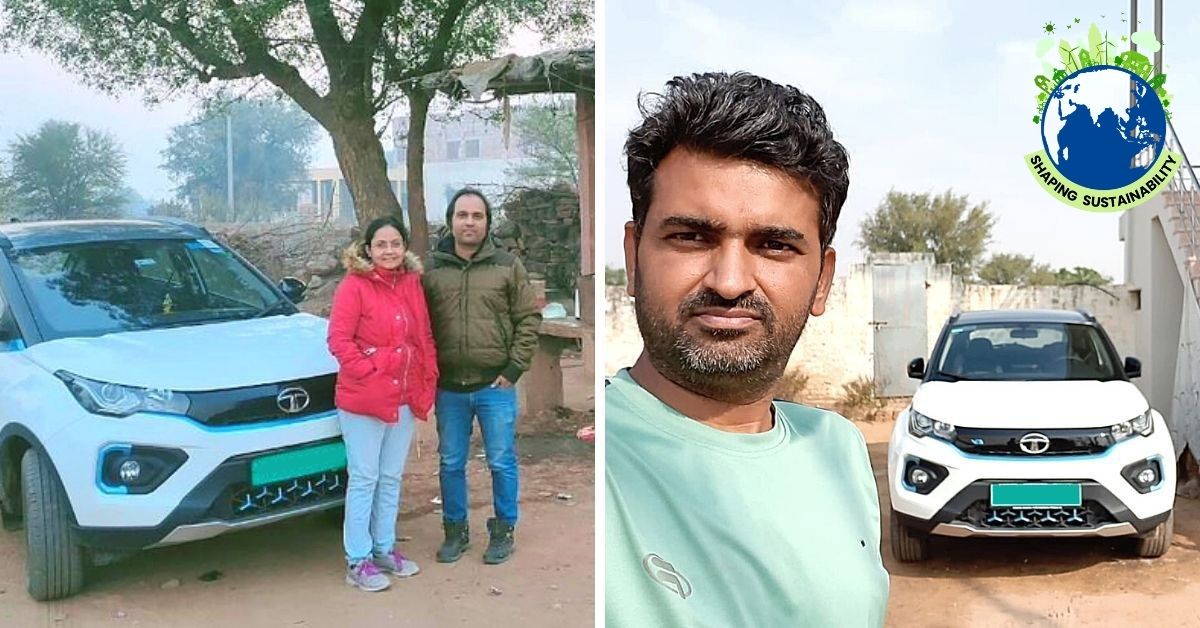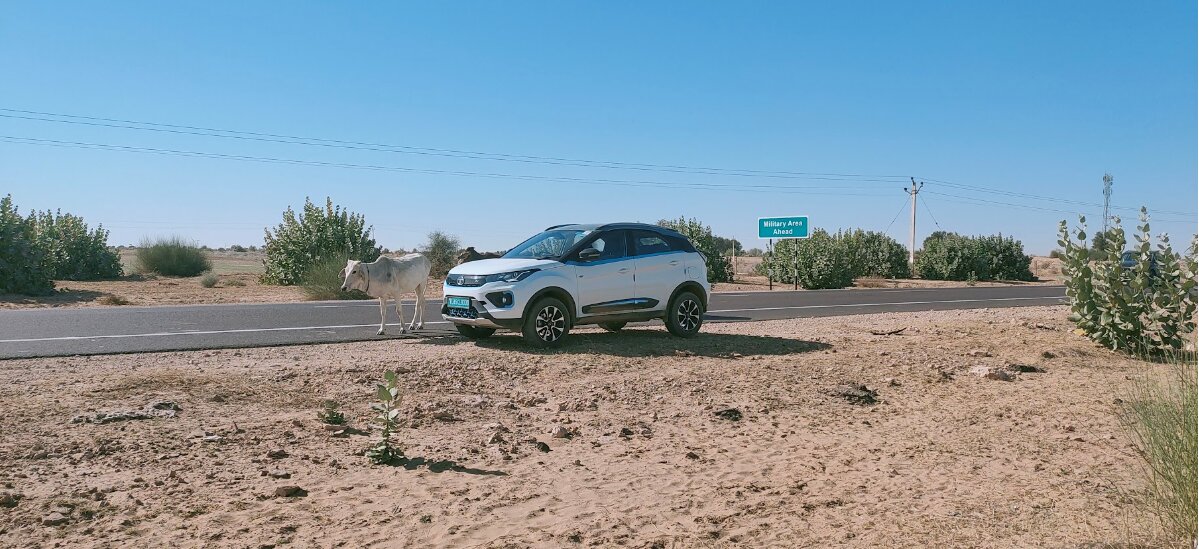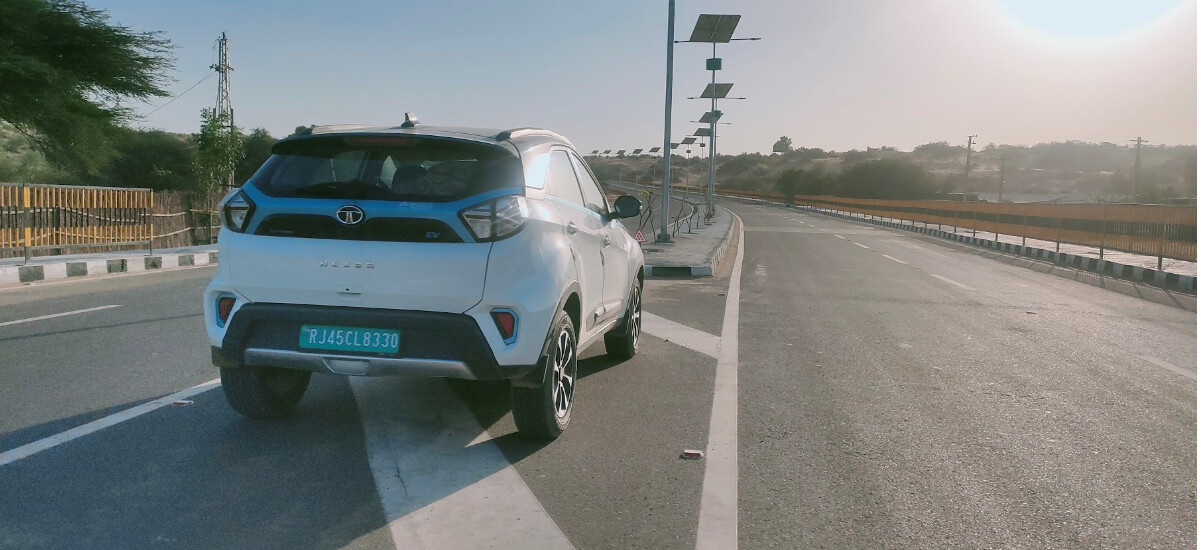Complete Guide to EV Road Tripping In India: What 3 Real World Experiences Revealed
Planning to purchase an electric vehicle? Three EV owners share all about range anxiety, fast chargers, the right way to drive, and other things to keep in mind.

This article is part of a deep dive into Electric Vehicles in India. #EVinIndia is the first chapter of ‘Shaping Sustainability’, an exclusive series by The Better India to give our readers an in-depth understanding of how Indians are making sustainability a priority in all walks of life. Find more stories from the series, here.
Gurugram-based Rakesh confidently declares that now is the best time to purchase an electric vehicle (EV). Given the rising petrol prices, the total amount you spend per litre on petrol can fetch you an EV, he adds.
He is a proud owner of a four-wheeler Tata Nexon and two-wheeler (e2w) Honda’s Electric Optima HS500. It has been more than five years since rising petrol rates are making no difference to his life. In fact, he claims to have saved lakhs of rupees which has almost covered the purchasing cost of his car.
“If you follow the global trends around the world, you will notice that countries are becoming less and less dependent on each other. And EVs can help us become self-reliant without harming the environment,” Rakesh tells The Better India.
But is this independence and cost-saving measure worth risking your life?
Anjnay Saini from Delhi asked this question when he was stranded at -14 degrees C at a height of 5000 metres above the ground in Ladakh. His road trip to the pristine region last year gave him a reality check.
“It was a matter of life and death. At very high altitudes, the sand is replaced by clay on the ground and starting a car is difficult on such terrain. I was unable to do so and the freezing temperatures only made the whole thing worse. My car had run out of battery and waiting for electricity to come was becoming unbearable with every passing minute I developed breathing issues too. It was a risky affair but I managed to come out of it. My advice would be to wait for the power to come and then take a road trip to this windswept and treacherous landscape,” Anjnay says.
On the other hand, Aakash, another EV- owner who travelled a roundtrip from Jaipur to Longewala on the Indo-Pak border, passing through Pushkar, Jodhpur and Jaisalmer in four days, says there are disadvantages to driving an EV if you are ignorant.
“You can make your road trip as smooth and enjoyable as a petrol or diesel vehicle provided you have a concrete plan on charging infrastructure. I have driven approximately 33,000 km and personally, it is a day and night difference when compared to a petrol vehicle. My shift to EVs has been totally worthy,” Aakash says.

While Rakesh, Anjnay and Aakash have had different experiences with their EVs; when put to a vote the collective conclusion is in favour of zero tailpipe emission vehicles.
And this seems to be the growing trend across India.
As per the Society of Manufacturers of Electric Vehicles (SMEV), India expects to sell close to 1 million units in 2022, equal to what was sold collectively in the last 15 years.
“We haven’t seen better days than the last few months in the entire EV journey. In the last 15 years, we collectively sold around 1 million e2w, e-three wheelers, e-cars, and e-buses, and we will most likely sell the same 1 million units in just one year beginning January 2022,” SMEV Director General Sohinder Gill told PTI.
Calculate Running Cost of EV & Fuel Vehicle
 Fuel Vehicle
Fuel Vehicle
 Electric Vehicle
Electric Vehicle
 Fuel Vehicle
Fuel Vehicle
 Electric Vehicle
Electric Vehicle

Total Savings
No Savings
Go for EVs with 3 ‘P’s

The trio is happy seeing this growing trend but their only suggestion is to ‘Plan, Prepare and then Progress’ before rushing in with the down payments.
It is a no-brainer that EVs have clear benefits. They are good for their environment, have lower lifetime running costs than internal combustion engine (ICE) cars, are tech-savvy and of course, saves you money in the long run.
However, as we flip the coin, it is imperative to look at the other side. Issues such as a lack of fast-charging stations and limited battery size, which can stop you from out-of-town excursions, should be taken into account.
“It is not hard to identify and address the limitations via KYC or Know Your Car. Before embarking on any adventure, know the capabilities of your vehicle and prepare accordingly. For instance, I know my car can run for 300 km on a single charge. So I try to cover a distance of at least 280 km on a single charge in regions where there is no EV infrastructure. I plan my trip in a way that after 300 km, there should be a charging station,” says Rakesh.
“Understand how your car works by driving a few kilometres. You will know how far it is going to go without having to charge and of course the way you drive makes a difference. It is possible to predict the range anxiety,” adds Aakash.
But how does one go about doing that?
Plan Your Charging Routes & Stops

One of the first things Anjnay did during his previous road trip from Delhi to Spiti valley was to call all the hotels he was going to stay at to enquire about charging facilities to ensure there were no surprises later. He carried an earthing kit for continuous current flow while charging and a 15-ampere charger.
With help from apps, he identified three DC (Direct Current) charging stations — Statiq, TataEZ and Forteum, on his route.
Knowing that dhabas and restaurants have AC (Alternate Current) charging that is slow, their rest stops were planned in a way that gave him and his friends time to eat, rest or sleep while the car was charging.
Watch Anjnay’s Ladakh trip here:
He drove on India’s first EV-friendly highway, which has chargers at regular intervals of 25-30 km from Delhi to Chandigarh.
But if his Spiti trip was smooth, there were some hiccups on his Ladakh trip.
“For my Delhi to Ladakh trip, I charged seven times, spending about 18 hours to cover 2,000 km. I did have to switch to petrol for a few kilometres and spend Rs 1,500 on it in areas where there was absolutely no power. Overall I spent Rs 3,000 on this road trip which is still significantly less than a petrol-based car trip,” he adds.
Other apps such as Tata Power’s EZ Charge and Zeon Charging and Google Maps can also help in locating charging stations.
As for Aakash, he followed a similar plan and called hotels in advance to ensure electricity was available.
“We also ensured that every 200-odd km, we planned a stop at a hotel or any such establishment to charge the EV. At every place we stopped for the night, we charged our car for a good 10 to 11 hours,” he says.

An electric engineer by profession, he also invented a solution to his range anxiety in the form of a DIY kit.
With a one-time investment cost of Rs 8,000, he made an earthing kit (an iron rod covered by copper wire is inserted into the ground). This kit protects against unwarranted spikes of electricity that can cause damage to the vehicle.
“All one has to do is pitch the iron rod into the ground and connect a wire to it and the vehicle charger. The kit contains an extension cable with an energy metre, an indicator to note if the wiring is okay, an iron rod, a copper plate and any other equipment one needs on long EV road trips. This product is available on the Aha3D website,” he says.
Your Driving Style Matters

For both his trips, Anjnay identified routes that were downhill for the regenerative braking. He followed a thumb rule: “One kilometre takes 1% of battery charge on an upward slope and for downhill, the same percentage can cover 4 km, thanks to kinetic energy. ‘Stop-pedal-accelerator’ became my motto. Almost 40% of that route was downhill, so we were able to regenerate 30% charge for our Spiti trip.”
To help users benefit from this concept, Tata in December 2021 had announced that the new Nexon EVs will have options to select re-gen modes which will allow the driver to adjust the intensity of the regenerative braking.
Aakash also mentions focussing on speed and acceleration. He says that if you want to cover long distances, refrain from changing speeds and over accelerating as the battery can degenerate faster. Sudden braking also eats up a lot of battery.
“For example, if you’re driving at 80 kmph, you get a range of 200-220 km. But if you discover that this is not good enough, you can always start driving 40 kmph, and this will increase your range to over 300 km. Therefore, at no point were we stranded. Although the company claims a range of 312 km, if the Tata Nexon is driven at speeds of 90-100 kmph, the battery range drops to about 160 km on a single charge. If they drive like monks at speeds of 40 kmph, they can extend the range to up to 320 km,” observes Aakash, whose personal best is 340 km on a single charge.
What About Two-Wheelers?

Rakesh says that despite the shortcomings of his e2w, he has had a good experience.
“The quality of the vehicle might not be the best as the panels and shock absorbers are very basic. But I am okay with it as saving on petrol is more important for me. I use it for commuting within the city as it gives a range of 110 km on a single charge,” he says.
He invested in the bike only after calculating its running cost and discovered that he can recover the Activa cost within two years by not spending anything on petrol.
Since he has a solar hybrid inverter at home, charging his car and two-wheeler is convenient. E2w has removable batteries.
His suggestion to potential buyers is to opt for a scooter that has lithium-iron-phosphate or lithium nickel manganese cobalt oxide batteries.
“When picking a vehicle, look for three parts — battery, motor and controller,” he adds.
Key Points for EV Road Trips:
Anjnay says:
- Need to have the right mindset.
- Do not get scared in difficult terrains, think properly to get a solution.
- Always carry the necessary equipment and do proper planning.
Aakash says:
- If your driving is less than 1500 km per month, then do not buy an EV. Car is an asset from day one if you cover more than 2000 km.
- Tata Nixon intended to be a city car so the range isn’t highway worthy. With fast-changing stations coming up, smooth driving on the highway seems like a near possibility.
Rakesh says:
You are mistaken if you think an EV is expensive. It is possible to cover the ownership cost. I managed to save Rs 10,00,000 in four years on fuel, which is the cost of the car when I had purchased it a few years ago.
Sources
Edited by Yoshita Rao
If you found our stories insightful, informative, or even just enjoyable, we invite you to consider making a voluntary payment to support the work we do at The Better India. Your contribution helps us continue producing quality content that educates, inspires, and drives positive change.
Choose one of the payment options below for your contribution-
By paying for the stories you value, you directly contribute to sustaining our efforts focused on making a difference in the world. Together, let’s ensure that impactful stories continue to be told and shared, enriching lives and communities alike.
Thank you for your support. Here are some frequently asked questions you might find helpful to know why you are contributing?


This story made me
-
97
-
121
-
89
-
167











